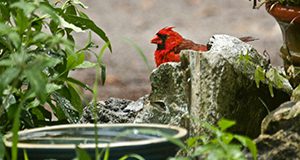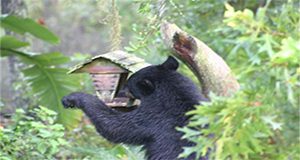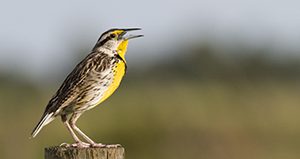A variety of forest birds will use trees and shrubs in built areas as breeding, wintering, and stopover habitat. Scientists have created an online tool to help these birds and the people who appreciate them. This 20-page fact sheet written by Mark Hostetler and Jan-Michael Archer and published by the UF/IFAS Department of Wildlife Ecology and Conservation describes the online tool and shows how it can help forest birds.
edis.ifas.ufl.edu/uw418
Tag: Wild Birds
Securing Bird Feeders from Florida Black Bears
The Florida black bear (Ursus americanus floridanus) is the only species of bear in Florida, with an estimated population of approximately 4,030 bears. Bears are excellent climbers and can access bird feeders that are suspended from trees. This 3-page fact sheet written by Ethan T. Noel and Elizabeth F. Pienaar and published by the Wildlife Ecology and Conservation Department explains how to secure bird seed from bears so that they don’t become reliant on human food sources, a condition that puts them at greater risk of being killed from vehicle collisions, illegal shooting, or euthanasia.
http://edis.ifas.ufl.edu/uw430
Building for Birds Evaluation Tool: Breeding and Wintering Habitat for Forest Birds
Several bird species use forest fragments and trees conserved in built areas as breeding, wintering, and stopover habitat. Scientists have created a Building for Birds online tool to help these birds and the people who appreciate them. This evaluation tool is most useful for small developments or developments in already fragmented landscapes.
The tool is designed for use when no opportunity is available to conserve large forest areas of 125 acres or more within a proposed development. Developers are sometimes reluctant to conserve trees and forest fragments in subdivided residential/commercial areas because it costs time and money, but there is value in this conservation effort not only for many different species of forest birds, but for future homeowners waking to birdsong in the mornings.
This 17-page fact sheet written by Mark Hostetler and Jan-Michael Archer and published by the Department of Wildlife Ecology and Conservation describes the online tool and shows how it can help preserve breeding and wintering habitat for migrating birds.
http://edis.ifas.ufl.edu/uw417
Building for Birds Evaluation Tool: Forest Fragments Used as Stopover Sites by Migrant Birds
Several bird species use forest fragments and trees conserved in built areas as breeding, wintering, and stopover habitat. Scientists have created a Building for Birds online tool to help these birds and the people who appreciate them. This evaluation tool is most useful for small developments or developments in already fragmented landscapes.
The tool is designed for use when no opportunity is available to conserve large forest areas of 125 acres or more within a proposed development. Developers are sometimes reluctant to conserve trees and forest fragments in subdivided residential/commercial areas because it costs time and money, but there is value in this conservation effort not only for many different species of forest birds, but for future homeowners waking to birdsong in the mornings.
This 18-page fact sheet written by Mark Hostetler and Jan-Michael Archer and published by the Department of Wildlife Ecology and Conservation describes the online tool and shows how it can help preserve stopover habitat for migrating birds.
http://edis.ifas.ufl.edu/uw416
Checklist of Birds of the Everglades Agricultural Area (CIR1444/UW179)
This revised 10-page fact sheet features a checklist of bird species that have been found during eight years of surveys in the Everglades Agricultural Area. Most birds can be associated with a specific habitat such as sugarcane, sod, rice or flooded fields and other agricultural and human-inhabited areas. Written by Elise V. Pearlstine and Frank J. Mazzotti, and published by the UF Department of Wildlife Ecology and Conservation, November 2010.
http://edis.ifas.ufl.edu/uw179
Attracting Backyard Birds: Bird Feeder Selection (WEC162/UW192)
Today, more than 50 million Americans put out a billion pounds of bird food each year. Bird feeders can be used to supplement the food provided by native plantings. They also provide a way to observe birds at close range. This 8-page fact sheet suggests useful guidelines for selecting feeders, food, feeder location, cleaning feeders, and managing for cats and squirrels. Written by Emma V. Willcox, Mark E. Hostetler, Martin B. Main, and Maena Voigt, and published by the UF Department of Wildlife Ecology and Conservation, April 2011.
http://edis.ifas.ufl.edu/uw192
WEC298/UW343 Forest Remnants: Conserving and Observing Bird Diversity in Urban Settings
WEC298, a 7-page illustrated fact sheet by Dan Dawson and Mark Hostetler, discusses urban forest remnant design and management as it relates to bird conservation. Includes references. Published by the UF Department of Wildlife Ecology and Conservation, September 2010.
http://edis.ifas.ufl.edu/uw343
WEC264/UW309 Florida’s Wading Birds
WEC-264, an 11-page illustrated fact sheet by Grant C. Sizemore, Martin B. Main, and Elise V. Pearlstine, provides an overview of some of the most majestic of Florida's birds — taxonomy and status, cranes and flamingos, identification, feeding behavior, diet, breeding, movements, and conservation. Includes references. Published by the UF Department of Wildlife Ecology and Conservation, July 2009.
http://edis.ifas.ufl.edu/UW309
WEC261/UW306 The Florida Scrub-Jay: A Species in Peril
WEC-261, a 6-page illustrated fact sheet by Steve A. Johnson, Karl E. Miller, and Travis Blunden, provides biological information about the Florida Scrub-Jay and the unique habitat it depends on for survival. It also includes advice for how people can help conserve this unique and imperiled bird. Published by the UF Department of Wildlife Ecology and Conservation, June 2009.
http://edis.ifas.ufl.edu/UW306



